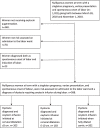Labor dystocia and oxytocin augmentation before or after six centimeters cervical dilatation, in nulliparous women with spontaneous labor, in relation to mode of birth
- PMID: 35562716
- PMCID: PMC9107162
- DOI: 10.1186/s12884-022-04710-2
Labor dystocia and oxytocin augmentation before or after six centimeters cervical dilatation, in nulliparous women with spontaneous labor, in relation to mode of birth
Erratum in
-
Correction: Labor dystocia and oxytocin augmentation before or after six centimeters cervical dilatation, in nulliparous women with spontaneous labor, in relation to mode of birth.BMC Pregnancy Childbirth. 2024 Feb 2;24(1):106. doi: 10.1186/s12884-024-06292-7. BMC Pregnancy Childbirth. 2024. PMID: 38308242 Free PMC article. No abstract available.
Abstract
Background: The effects of diagnosing and treating labor dystocia with oxytocin infusion at different cervical dilatations have not been fully evaluated. Therefore, we aimed to examine whether cervical dilatation at diagnosis of dystocia and initiation of oxytocin infusion at different stages of cervical dilatation were associated with mode of birth, obstetric complications and women's birthing experience.
Methods: A retrospective cohort study, including 588 nulliparous term women with spontaneous onset of labor and dystocia requiring oxytocin augmentation. The study population was divided into three groups according to cervical dilatation at diagnosis of dystocia and initiation of oxytocin-infusion (≤ 5 cm, 6-10 cm, fully dilated) with mode of birth as the primary outcome. Secondary outcomes were obstetrical and neonatal complications and women´s experience of childbirth. Statistical comparison between groups using Chi-square and ANOVA was performed. The risk of operative birth (cesarean section and instrumental birth) was assessed using binary logistic regression with suitable adjustments (maternal age, body mass index and risk assessment on admission to the labor ward).
Results: The cesarean section rate differed between the groups (p < 0.001); 12% in the ≤ 5 cm group, 6% in the 6-10 cm group and 0% in the fully dilated group. There was no increased risk for operative birth in the ≤ 5 cm group compared to the 6-10 cm group, adjusted OR 1.28 95%CI (0.78-2.08). The fully dilated group had a decreased risk of operative birth (adjusted OR 0.48 95%CI (0.27-0.85). The rate of a negative birthing experience was high in all groups (28.5%, 19% and 18%) but was only increased among women in the ≤ 5 cm group compared with the 6-10 cm group, adjusted OR 1.76 95%CI (1.05-2.95).
Conclusions: Although no difference in the risk of operative birth was found between the ≤ 5 cm and 6-10 cm cervical dilatation-groups, the cesarean section rate was highest in women with dystocia requiring oxytocin augmentation at ≤ 5 cm cervical dilatation. This might indicate that oxytocin augmentation before 6 cm cervical dilatation could be contra-productive in preventing cesarean sections. Further, the increased risk of negative birth experience in the ≤ 5 cm group should be kept in mind to improve labor care.
Keywords: Active labor; Birth experience; Cesarean section; Labor dystocia; Oxytocin augmentation.
© 2022. The Author(s).
Conflict of interest statement
The authors declare that they have no competing interests.
Similar articles
-
Applying a physiologic partograph to Consortium on Safe Labor data to identify opportunities for safely decreasing cesarean births among nulliparous women.Birth. 2018 Dec;45(4):358-367. doi: 10.1111/birt.12358. Epub 2018 May 30. Birth. 2018. PMID: 29851163 Free PMC article.
-
First assessed cervical dilatation: is it associated with oxytocin augmentation during labour? A retrospective cohort study in a university hospital in Switzerland.Midwifery. 2020 Jun;85:102683. doi: 10.1016/j.midw.2020.102683. Epub 2020 Feb 26. Midwifery. 2020. PMID: 32200140
-
Physiologic partograph to improve birth safety and outcomes among low-risk, nulliparous women with spontaneous labor onset.Med Hypotheses. 2012 Feb;78(2):319-26. doi: 10.1016/j.mehy.2011.11.012. Epub 2011 Dec 3. Med Hypotheses. 2012. PMID: 22138426 Free PMC article.
-
Effect of partograph use on outcomes for women in spontaneous labour at term and their babies.Cochrane Database Syst Rev. 2018 Aug 6;8(8):CD005461. doi: 10.1002/14651858.CD005461.pub5. Cochrane Database Syst Rev. 2018. PMID: 30080256 Free PMC article.
-
Epidural analgesia in labor and cesarean delivery for dystocia.Obstet Gynecol Surv. 1994 May;49(5):362-9. doi: 10.1097/00006254-199405000-00027. Obstet Gynecol Surv. 1994. PMID: 8015757 Review.
Cited by
-
Timing of hospital admission at first childbirth: A prospective cohort study.PLoS One. 2023 Feb 16;18(2):e0281707. doi: 10.1371/journal.pone.0281707. eCollection 2023. PLoS One. 2023. PMID: 36795737 Free PMC article.
-
Correction: Labor dystocia and oxytocin augmentation before or after six centimeters cervical dilatation, in nulliparous women with spontaneous labor, in relation to mode of birth.BMC Pregnancy Childbirth. 2024 Feb 2;24(1):106. doi: 10.1186/s12884-024-06292-7. BMC Pregnancy Childbirth. 2024. PMID: 38308242 Free PMC article. No abstract available.
-
Maternal age and body mass index and risk of labor dystocia after spontaneous labor onset among nulliparous women: A clinical prediction model.PLoS One. 2024 Sep 6;19(9):e0308018. doi: 10.1371/journal.pone.0308018. eCollection 2024. PLoS One. 2024. PMID: 39240838 Free PMC article.
References
-
- Socialstyrelsen. Indikation för värkstimulering med oxytocin under aktiv förlossning (Indication for augmentation with oxytocin during active labor). 2011 2011 08/01 Report No 2011 18


